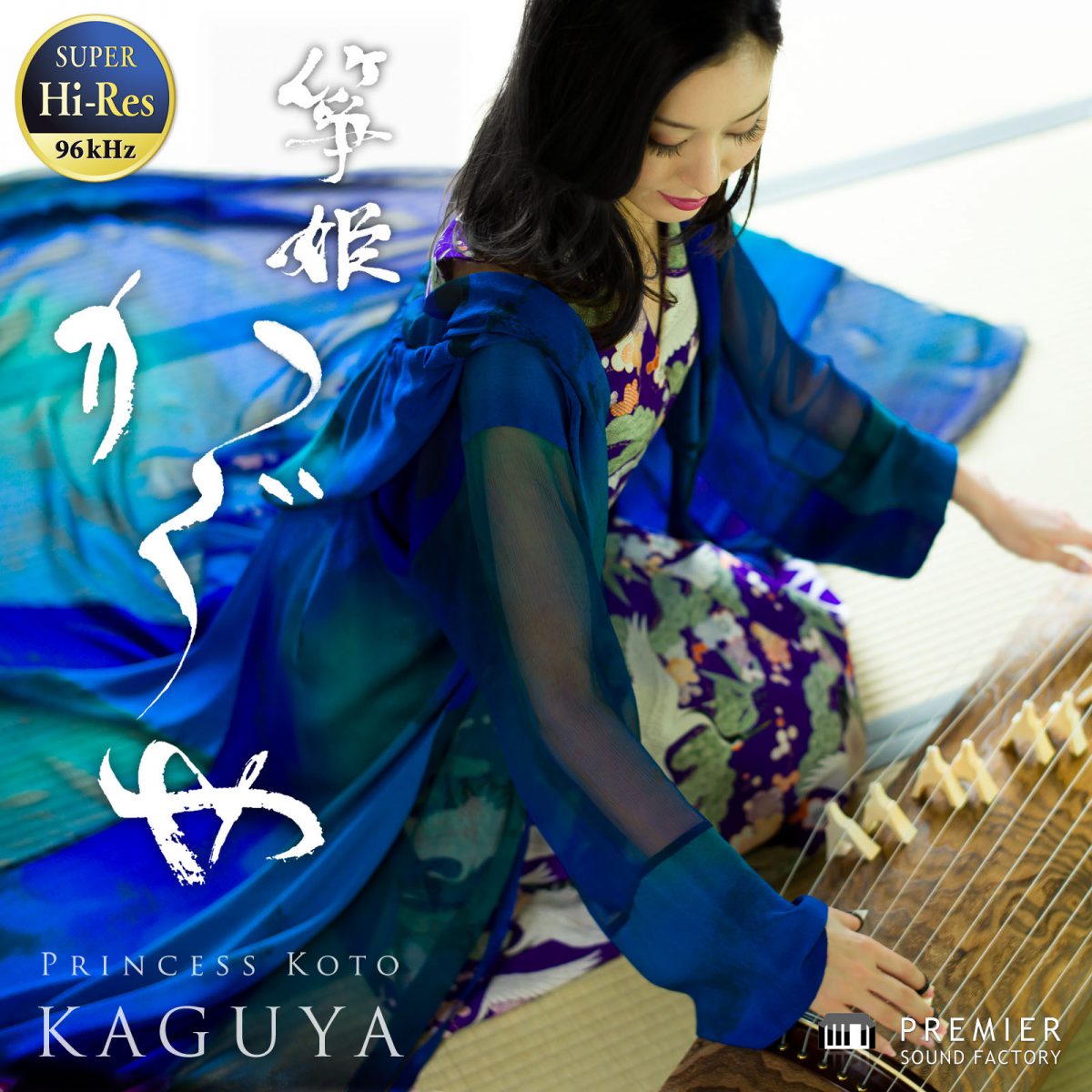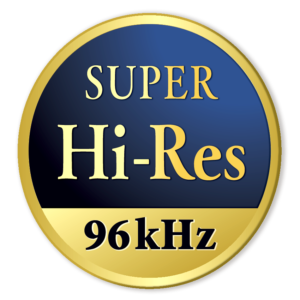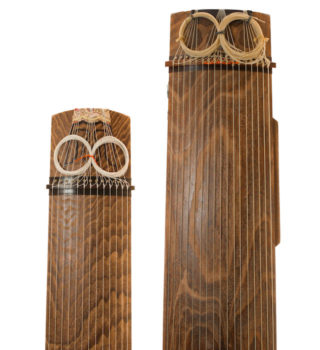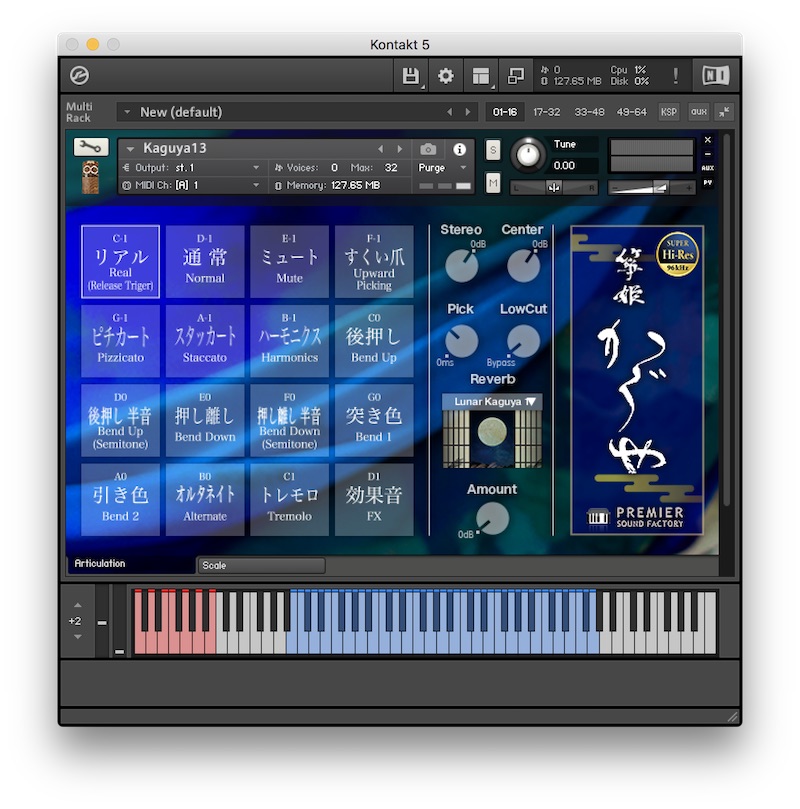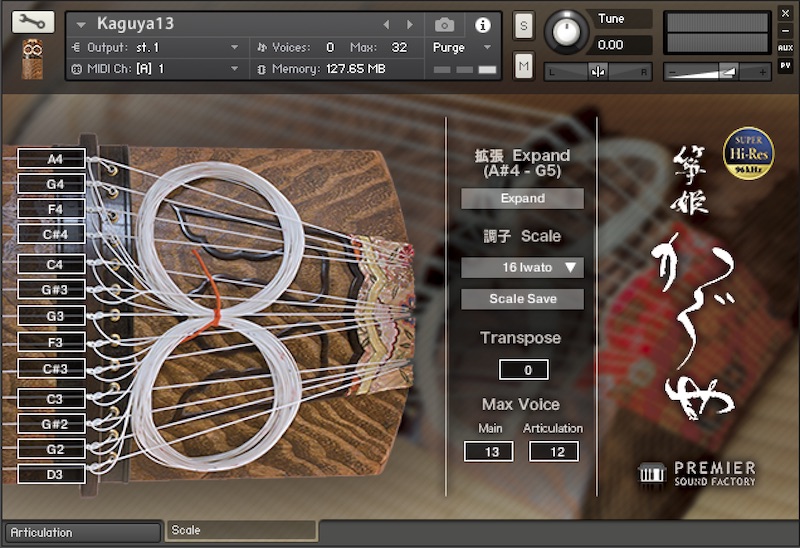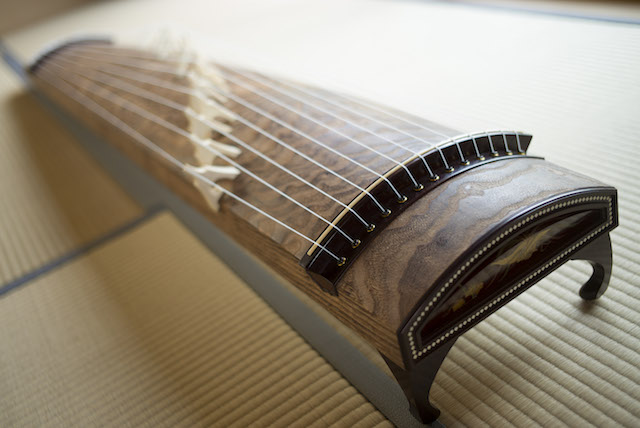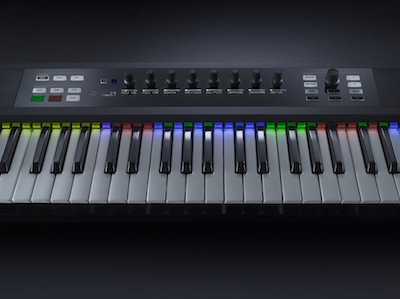Princess Koto KAGUYA
PREMIER SOUND FACTORY
SAMURAI Classics – Japanese Koto instrument library
for Kontakt & Free Kontakt Player.
A Duo of Classical and Contemporary Koto Included
- Japanese Koto: a 13 string instrument
- 17 string bass Koto, similar to a Cello.
The 13 string Koto covers B1-A4, simulating a typical Koto (Normal mode). Expand mode increases the range to A#4 – G5, with the use modern high pitched Koto. Kaguya covers the whole wide range of Koto instruments.
13 strings B1 – G5
17 strings C1 – E3
Complete playing style capability
All conventional Koto playing methods typically used in traditional Japanese music are covered. It is easy to switch between all 16 available styles with the simple and intuitive articulation panel and key switch.
For example, when using the “Real” style, note on begins the picking sound, and note off provides the sound of the string as you release the key. For “Normal” “Staccato”etc, note on creates a slight delay for the string sound after picking, to replicate a real koto. The delay time can be controlled using the pick knob, zero to 100ms.
The pitch bending (Up and down) aspect of Koto playing is achieved through the timing of releasing your keyboard, therefore you can control the timing of your bends to match the tempo of your song.
214 audio phrase patterns are also included, such as glissando etc.
- Real/Release Trigger (Picking sound as note is pressed, string sound as note is released. Similar to real Koto style)
- Normal (Picking and string as note is pressed)
- Upward Picking
- Mute
- Pizzicato
- Staccato
- Harmonics
- Pitch/Bend up
- Pitch/Bend up semitone
- Pitch/Bend down
- Pitch/Bend down semitone
- Bend 1 (The combination of up & down)
- Bend 2 (Slightly pulling the string into a downward bend)
- Alternate (Alternating down and upstroke playback)
- Tremolo
- FX
36 traditional Japanese scales
As well as the standard chromatic scale, traditional Japanese scales can be assigned to the white keys of your keyboard. It is also possible to save up to 20 of your own original scales. You can perform glissando with white keys just like a real koto.
When using a preset, the top note of the 13 strings, A4, will automatically have tremolo assigned to the next black key, A#4. From this it is possible to reproduce SARARIN typical of traditional koto playing style, the combination of tremolo and glissando, without using any key switch. (F#4, G#4 also have the same automatic tremolo.)
The classic scales are usually played with the 13 string koto. However when using Expand Mode, the assigned scales intelligently and automatically extend to meet the higher/extra notes covered in Expand Mode.
All factory presets and user presets can be transposed to fit your song.
One of the reasons for the beautiful cosmic sound created by a Koto is that, similar to the way the pedals on a piano work, you are not only hearing the string that is being plucked, but also the vibrations and resonance that pass through all of the other strings and fill the surrounding air in all directions.
When recording the 13 string Koto, we captured all keys with authentic Koto scales. That’s why KAGUYA is imbued with super natural and beautiful vibration, typical of Kotos.
* The 17 String bass Koto is a contemporary instrument which was not used in the past. Therefore the 17 string koto only has the chromatic scale.
KAGUYA scale preset list
Traditional Japanese Scales
|
preset |
Name |
調律名 |
|
|
1 |
01 Chromatic |
01 クロマチック |
– |
|
2 |
02 Hira (minor Basic) |
02 平調子 |
minor |
|
3 |
03 Kumoi |
03 雲井調子 |
minor |
|
4 |
04 Hon-Kumoi |
04 本雲井調子 |
minor |
|
5 |
05 Han-Kumoi |
05 半雲井調子 |
minor |
|
6 |
06 Kata-Kumoi |
06 片雲井調子(四九上がり調子) |
minor |
|
7 |
07 4 Agarihan-Kumoi |
07 四上がり半雲井 |
minor |
|
8 |
08 Hen-Kumoi |
08 変雲井調子 |
minor |
|
9 |
09 Nakazora |
09 中空調子(六上がり調子) |
minor |
|
10 |
10 Akebono |
10 曙調子 |
minor |
|
11 |
11 Han-Nakazora |
11 半中空調子 |
minor |
|
12 |
12 Gaku (Major Basic) |
12 楽調子 |
Major |
|
13 |
13 Han-Gaku (Major) |
13 半楽調子 |
Major |
|
14 |
14 Dai-Gaku (Major) |
14 大楽調子(花雲調子) |
Major |
|
15 |
15 Nogi (Major) |
15 乃木調子(第二楽調子) |
Major |
|
16 |
16 Iwato |
16 岩戸調子 |
minor |
|
17 |
17 Han-Iwato |
17 半岩戸調子 |
minor |
|
18 |
18 Natsuyama (Major) |
18 夏山調子 |
Major |
|
19 |
19 Kokin |
19 古今調子 |
minor |
|
20 |
20 Shin-Kokin |
20 新古今調子 |
minor |
|
21 |
21 Hira-Kinju |
21 平巾十調子 |
minor |
|
22 |
22 Niju-Kumoni |
22 二重雲井調子 |
minor |
|
23 |
23 Kumoi-Kinju |
23 雲井巾十調子 |
minor |
|
24 |
24 Akino (Major) |
24 秋野調子 |
Major |
|
25 |
25 Akikaze |
25 秋風調子 |
minor |
|
26 |
26 Meibai |
26 明梅調子 |
minor |
|
27 |
27 Ozora |
27 大空調子 |
minor |
|
28 |
28 Sofuren1 (Major) |
28 想夫恋の調子(嵯峨の秋) |
Major |
|
29 |
29 Sofuren2 |
29 想夫恋調子(古今新組) |
minor |
|
30 |
30 Orgel |
30 オルゴール調子(オランダ調子) |
minor |
|
31 |
31 Kankan (Major) |
31 カンカン調子 |
Major |
|
32 |
32 Ryukyu (Major) |
32 琉球本調子 |
Major |
|
33 |
33 Minyo (Major) |
33 民謡調子 |
Major |
|
34 |
34 Haruno Umi |
34 春の海 |
minor |
|
35 |
35 Sanka |
35 賛歌 |
minor |
|
36 |
36 Tone Kaze |
36 遠音 風 |
minor |
Other features
Stereo and center microphones are editable independently. Lo-cut is effective when you want to distance the stereo image arrangement. It can be hard bypassed when Lo-cut knob is zero.
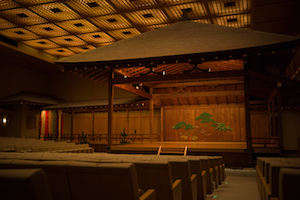 Five varieties of convolution reverb are included. IR recorded in authentic, time honored Japanese Noh theatre.
Five varieties of convolution reverb are included. IR recorded in authentic, time honored Japanese Noh theatre.
And the image of Princess Kaguya’s moon also relates to the long, ethereal and mysterious reverb of the Koto, uniting both themes of Princess Koto – Kaguya.
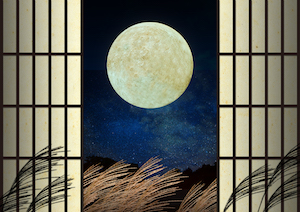 From the moment you load this Koto sound library and let it ring out on your keyboard, the deeply stirring sound and emotion you will experience is something that the PREMIER Team has been striving to capture for the last 20 years. As the near mythical and magical Koto chords start ringing out, endless musical inspiration will take hold of you!
From the moment you load this Koto sound library and let it ring out on your keyboard, the deeply stirring sound and emotion you will experience is something that the PREMIER Team has been striving to capture for the last 20 years. As the near mythical and magical Koto chords start ringing out, endless musical inspiration will take hold of you!
Kaguya ver 1.20 Updated
– Numeric display function added to all knobs, and numeric input is also possible.
– Detail levels (dB) of knob parameter are now displayed in the status bar of Kontakt.
– Added indicator of the string (Key) that is currently played on the scale tab. (Only in scale mode)
– Increased an intermediate velocity map around 105.
– Readjusted velocity mapping for the smooth connection.
– Adjusted levels of Bend Up and Down.
– Removed some noises of some samples.
– Minor bugs fixed.
TIPS
Kontakt’s snapshot function is useful when you want to unify the settings with multiple Kaguyas. You can easily save and assign settings.
KAGUYA – Specification
| Instrument type: | KONTAKT Instrument |
| For use with: | FREE KONTAKT 5 PLAYER (included in free KOMPLETE PLAYERS), or KONTAKT 5(version 5.7 or higher) |
| Sound category: | Japanese Instruments |
| Number of sounds: | 2 Kotos, 16 Articulations, 36 Japanese scales, 214 Phrases. |
| Download size (Mac/PC): | 5 GB |
| System requirements: | Mac OSX 10.9 or higher (64bit only)Windows7 or higher (64bit only)4GB RAM, 5GB free disk space. Please also see the KONTAKT 5 PLAYER system requirements and the KONTAKT 5 PLAYER FAQ |
| Supported Interfaces: | Stand-alone, Audio Units, VST, ASIO, Core Audio, WASAPI, AAX Native (Win: Pro Tools 10 or higher, Mac: Pro Tools11 or higher) |
| DAW: | Cubase, Logic, Sonar, Studio One, Pro Tools, Ableton-Live, Digital Performer, Reaper, Sonar etc… |
| Sample Rate: | 96kHz / 24bit |
| Number of Samples: | 2,534 Samples |
| Number of Instruments: |
|
| Number of Sample Layers: | Max 16 layers (4 Velocities) |
| Cycle round-robin: | Max 2 |
| Channels: | Stereo |

Princess Koto KAGUYA
PREMIER SOUND FACTORY
SAMURAI Classics – Japanese Koto instrument library
for Kontakt & Free Kontakt Player.

